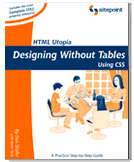HTML Utopia: Designing Without Tables Using CSS. Chapter 1: Getting the Lay of the Land | 2
JavaScript & HTML Utopia

Chapter 1: Getting the Lay of the Land
Almost as soon as the Web became popularized by the emergence of the first graphical Web browser (the forerunner to Netscape Navigator), graphic designers became aware of a problem. The method by which the Web browser displayed information stored in HTML files was not within the designer's control.
From their perspective, this constituted a fundamental flaw. "Users don't know anything about good design", they argued. If the designers couldn't control with great accuracy things like colors, fonts, and the precise, pixel-level positioning of every design element on the Web page, their creations could easily end up as ugly travesties in the user's browser.Excerpt Contents
|
Created: March 27, 2003
Revised: May 6, 2003
URL: https://webreference.com/programming/css_utopia/chap1


 Find a programming school near you
Find a programming school near you